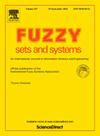在单位间隔上对最突出的制服类别进行了最新的调查
IF 2.7
1区 数学
Q2 COMPUTER SCIENCE, THEORY & METHODS
引用次数: 0
摘要
统一是由Yager和Rybalov作为t-norm和t- connorm的推广引入的。它们作为聚合函数和逻辑连接词被广泛研究。描述整类制服的完整结构仍然具有挑战性,因此已经提出了几类制服。2015年,Mas等人在实单位区间[0,1]和离散设置两个主要框架中编译了现有的uniform类。然而,近年来,关于实单位区间上一致通知类的刻画的理论研究取得了重大进展,特别是具有连续底层函数的一致通知类、在边界上是内的一致通知类和在非平凡切割上是内的一致通知类。这篇综述提出了一个仔细选择的结果,这些结果揭示了在实际单位区间上最突出的制服类的成员的结构。所选择的结果以一种类似于Ling基于Mostert和Shields的结果对连续t-norm的众所周知的结构描述的方式描述了一致的结构。为了确保我们报告的全面性和自成一体的性质,我们还简要介绍了2015年之前的发现,从而也便于后续发现的验证。由于篇幅有限,省略了几个重要的结果;然而,经典参考的主要部分是为感兴趣的读者提供的。本文章由计算机程序翻译,如有差异,请以英文原文为准。
A state-of-the-art survey of the most prominent classes of uninorms on the unit interval
Uninorms were introduced by Yager and Rybalov as a generalization of both t-norms and t-conorms. They have been studied extensively both as aggregation functions and as logical connectives. Describing the full structure of the entire class of uninorms remains challenging, and thus several classes of uninorms have been put forward. In 2015, Mas et al. compiled the existing classes of uninorms in two primary frameworks: the real unit interval and the discrete setting. However, in recent years, theoretical research on the characterization of the classes of uninorms on the real unit interval has made significant progress, especially for the class of uninorms with continuous underlying functions, the class of uninorms that are internal on the boundary, and the class of uninorms that are internal on non-trivial cuts. This review presents a careful selection of results that shed light on the structure of the members of the most prominent classes of uninorms on the real unit interval. The selected results describe the structure of uninorms in a way similar to the well-known structural description of continuous t-norms credited to Ling, based on a result by Mostert and Shields. To ensure the comprehensive and self-contained nature of our presentation, findings from before 2015 are also briefly presented, thereby also facilitating the verification of subsequent discoveries. Several significant results are omitted due to the limited space; however, the major part of the quintessential references is provided for the interested reader.
求助全文
通过发布文献求助,成功后即可免费获取论文全文。
去求助
来源期刊

Fuzzy Sets and Systems
数学-计算机:理论方法
CiteScore
6.50
自引率
17.90%
发文量
321
审稿时长
6.1 months
期刊介绍:
Since its launching in 1978, the journal Fuzzy Sets and Systems has been devoted to the international advancement of the theory and application of fuzzy sets and systems. The theory of fuzzy sets now encompasses a well organized corpus of basic notions including (and not restricted to) aggregation operations, a generalized theory of relations, specific measures of information content, a calculus of fuzzy numbers. Fuzzy sets are also the cornerstone of a non-additive uncertainty theory, namely possibility theory, and of a versatile tool for both linguistic and numerical modeling: fuzzy rule-based systems. Numerous works now combine fuzzy concepts with other scientific disciplines as well as modern technologies.
In mathematics fuzzy sets have triggered new research topics in connection with category theory, topology, algebra, analysis. Fuzzy sets are also part of a recent trend in the study of generalized measures and integrals, and are combined with statistical methods. Furthermore, fuzzy sets have strong logical underpinnings in the tradition of many-valued logics.
 求助内容:
求助内容: 应助结果提醒方式:
应助结果提醒方式:


